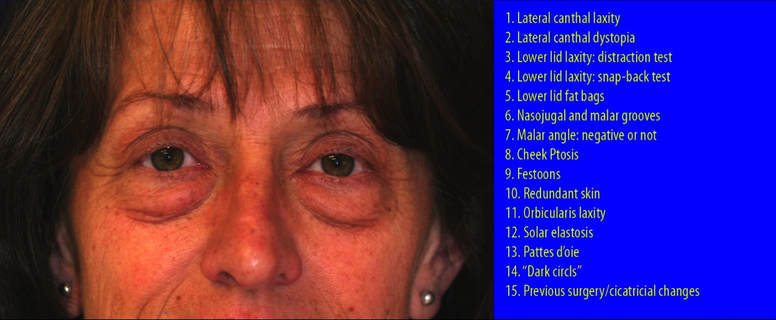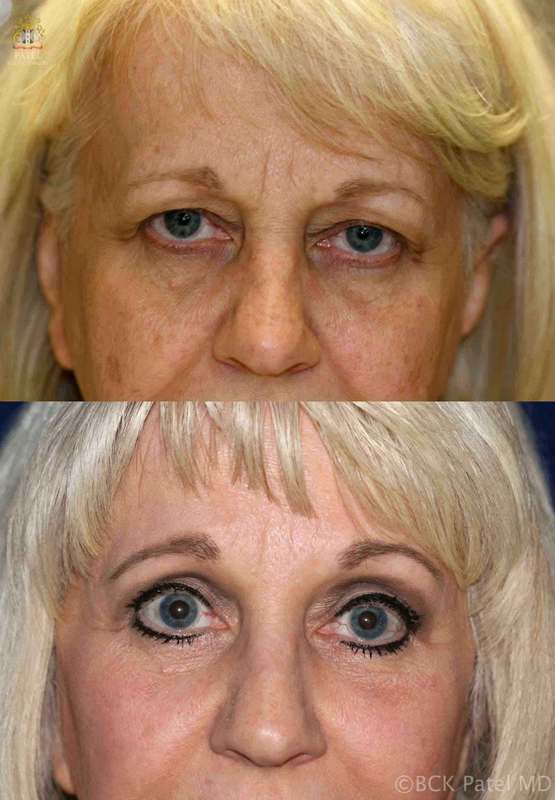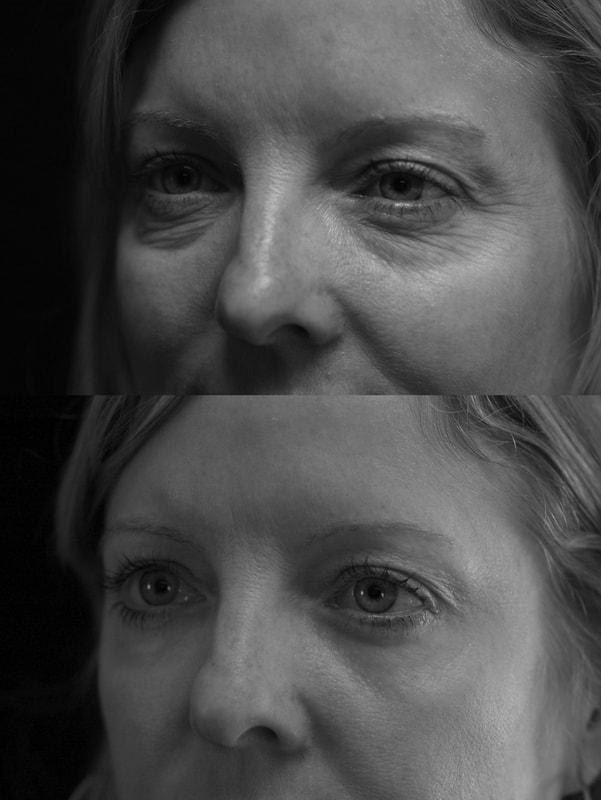bckpatel.info
Quick Connect St. George: St. George
What is Lower Blepharoplasty?
Lower blepharoplasty is the rejuvenation of the lower eyelids. Common complaints of lower eyelid aging include “bagginess” or “puffiness” of the lower eyelids, loose skin, lower eyelid laxity, dark circles and wrinkles. Improvement of these changes involves a combination of procedures which should result in a natural-looking lower eyelid, without the stigmata of surgery.
|
There is no one surgical technique that is used to reverse the aging changes because of the variations seen with age, sex, degree of laxity, degree of puffiness, fluid collection, pigmentation, bulges and grooves, wrinkles, scleral show and other factors!
Lower blepharoplasty is there for an amalgam of several different procedures, used in combination to give the ideal result. Even though we have come a long way since the first ever photographically recorded case of lower eyelid blepharoplasty (performed in France), we have to admire the overall result, albeit with some residual problems |
the first lower blepharoplasty in history : The French were first! |
"Real Self Review
"The most beautiful upper and lower blepharoplasty by Dr. Bhupendra Patel: thank you!
Overall rating *****
"The most beautiful upper and lower blepharoplasty by Dr. Bhupendra Patel: thank you!
- lavernecummings
- Bhupendra C.K. Patel, MD, Salt Lake City, UT
Overall rating *****
Am I a Candidate for Lower Blepharoplasty?Cosmetic lower blepharoplasty is performed when the patient is bothered by the appearance of the lower eyelids. Dr. Patel will examine you to ensure that the procedure may be performed safely. We see many patients for second, third and fourth opinions because of complications after blepharoplasty: we endeavor to ensure that our patients do not get any untoward results. Not all patients are suitable candidates for lower blepharoplasty.
|
"Well, the last time I had a picture taken I could hardly see my eyes because of the weight of heavy eyelid. Then I paid attention to how I was actually using my eyes and I really noticed when I was looking at anything especially the computer I was straining my forehead to see better. Since I have had it done I no longer have to lift the forehead and tilt my head to see. It is amazing! I love..." D. Rock 63 Yrs Old with Fat Droopy Eyes - Salt Lake City, UT
How will I be Assessed?
Without making it too complicated, it is important that the surgeon assesses all the factors that may affect the outcome of lower eyelid blepharoplasty and chosen techniques. Dr. Patel has designed a number of modifications to lower eyelid blepharoplasty (including the “Hammock Lift”) which give patients the very best results. It is my belief that cosmetic lower blepharoplasty is the most difficult and exacting of all cosmetic procedures.
What other Procedures May be Performed with Lower Blepharoplasty?
Patients may benefit from attention to upper eyelids (upper blepharoplasty), forehead and brow lifts, cheek lifts, face and neck lifts, fat injections, laser resurfacing and other facial and neck procedures. Please do not hesitate to ask us questions about any other aspects that may bother you. We always remind all our patients: no one NEEDS cosmetic surgery. But if you decide you would like to see an improvement in any aspect of the face, we will pay close and careful attention to ensure only appropriate and safe procedures are performed.
In the presence of a deep groove and ptosis of the cheek, it is unwise to perform just a lower blepharoplasty: your results will be ho-hum! In such instances, a midface elevation with fat transfer combined with a lower blepharoplasty gives the best result. If this applies to your anatomy, it is important to identify the factors before undergoing surgery!
An technique designed by Dr. Patel, called the “Hammock Lift” takes into account the aging of the lower eyelids, the midfacial tisues and the lower facial tissues and without performing a facelift, results far superior to just lower blepharoplasty:
In the presence of a deep groove and ptosis of the cheek, it is unwise to perform just a lower blepharoplasty: your results will be ho-hum! In such instances, a midface elevation with fat transfer combined with a lower blepharoplasty gives the best result. If this applies to your anatomy, it is important to identify the factors before undergoing surgery!
An technique designed by Dr. Patel, called the “Hammock Lift” takes into account the aging of the lower eyelids, the midfacial tisues and the lower facial tissues and without performing a facelift, results far superior to just lower blepharoplasty:
"My Hammock Lift is exactly what I needed, but did not know!! Dr. Patel explained to me how the Hammock Lift improves the upper two-thirds of the face, including brows, upper lids, forehead, lower lids and cheeks. I also got an improvement along my jawline which I am thrilled with as I plan on having a lower face and necklift later but this already gets me a great improvement. I have sent my two sisters to him! Brilliant surgeon. Cannot speak highly enough about him and his team. " J. Stevenson "Top marks"- Park City, UT
What kind of results can I expect after a Lower Blepharoplasty?Most patients will request a lower blepharoplasty because they “look tired”. To that end, beautifully performed lower blepharoplasty will remove that emotion when looking in a mirror! It is important to perform the surgery with subtlety abut accuracy: this way, the typical “operated look” of lower eyelid retraction, ectropion in more severe cases, and show of the white of the eye inferiorly can be prevented.
|
"I had a excellent eye lift done by Dr. Patel. He knows what he is doing and is very pleasant. Dr.Patel was easy to get an appointment and he works with you. The office staff was very pleasant and made you feel calm." D. Gull Highly recommended for eye lift surgery - Salt Lake City, UT
Schedule Your Consult Today |
Frequently Asked Questions
Where will my surgery be performed?
Most lower blepharoplasties are performed in an operating theatre for the sake of sterility and your comfort.
What kind of anesthesia will be used?
Sedation anesthesia (often called “twilight anesthesia”) works best as you are only sedated for the duration of the local anesthetic injections. Thereafter, the anesthesia team ensures that you are calm and comfortable. They will give you further medicine should you get anxious.
What kind of sutures are used?
In most cases, dissolving sutures are used which break up after about seven to fourteen days. They become itchy as they begin to dissolve and it is fine to gently scratch the incision line.. The prescribed ointment will also help with the itching, as will oral Benadryl (over-the-counter). There may be sutures on the outer corner of the eye, on the inner aspect of the lower eyelid and on the lower eyelids just below the eyelashes.
Do you use lasers for this surgery?
We use a number of tools, including lasers to give our patients the best possible results. Laser resurfacing, when performed in combination with a lower blepharoplasty gives a nice improvement in the skin texture, wrinkles and colour.
How long does the surgery take?
Most upper blepharoplasty procedures take 45 to 60 minutes operating time.
How much bruising and swelling will I have?
Everyone gets bruising and swelling after lower blepharoplasty! Care is taken during surgery to reduce the degree of bruising our patients get. We will also show you how to apply ice to the eyelids after surgery to reduce the swelling and bruising. The worst of the bruising and swelling is over within a week. However, some residual bruising and swelling can take another few days to disappear. Also, the use of the laser leaves the skin rather pink for the first week, after which the pinkness fades slowly. I always remind patients that “it takes us 20, 30, 40 years to age, so a few weeks of proper healing is not surprising.”
Does insurance cover lower blepharoplasty?
Cosmetic surgical procedures are never covered by insurance.
How painful is Lower Blepharoplasty?
There will be a sensation of tightness on the outer corner of the lower eyelids for the first couple of weeks. Numbness and a little stiffness of the lower eyelids is also to be expected. Because healing lower eyelids make the eye produce thicker tears, there will be some blurriness of vision. Only moderate pain is experienced by our patients. Most of my patients tell me they just need Tylenol or extra-strength Tylenol after surgery. And even that, just for the first one to two days.
Are there any restrictions and when may I return to work?
Most patients need to sleep with two to three pillows for the first two or three nights. This helps reduce the swelling more quickly. You may be up-and-about the very day of the surgery, albeit with some degree of blurry vision because of the healing eyelids. Gentle exercise (brisk walk on a treadmill or gentle cycling) may be resumed within two days. More vigorous exercise like skiing, tennis, etc may be resumed after 10 days. Driving may be difficult for the first two to three days because of blurry vision. Most patients return to work within a week.
What are the most common risks of Lower Blepharoplasty?
Bruising, swelling and blurry vision are not risks: they occur in every patient. Some degree of asymmetry is inevitable as this is always the case prior to surgery as well. Some degree of bleeding and oozing of blood-stained fluid for the first few days is also normal. Rarely, the dissolving sutures may break sooner if you sleep on your face or you sustain trauma: if this happens, putting in further sutures may be done in our clinic.
In the first few days, everyone will experience some degree of dryness and blurry vision. You will also feel that your lids look a little tight on the outer corner where you will also feel some of the deeper sutures if you put your finger there: this is of no concern. The tightness and the bumps under the skin settle over a few weeks.
More serious complications which are very rare include excessive bleeding, hemorrhage and loss of vision.
In the first few days, everyone will experience some degree of dryness and blurry vision. You will also feel that your lids look a little tight on the outer corner where you will also feel some of the deeper sutures if you put your finger there: this is of no concern. The tightness and the bumps under the skin settle over a few weeks.
More serious complications which are very rare include excessive bleeding, hemorrhage and loss of vision.
|
Visit Patel Plastic Surgery on YouTube for more free tips!
Stay Connected With Us On Social Media
|
Find UsLocations:
Dr. BCK Patel MD, FRCS 1025E 3300S Salt Lake City, Utah 84106, USA (801) 413-3599 (phone/text) E: [email protected] bckpatel.info Dr. BCK Patel MD, FRCS 585 E Riverside Dr Suite 201 Saint George, UT 84790 (435) 215-0014 E: [email protected] Quick-Link |
Let Us answer your questions |












